

Compact Muon Solenoid
LHC, CERN
| CMS-PAS-B2G-17-001 | ||
| Search for massive resonances decaying into WW, WZ, ZZ, qW and qZ in the dijet final state at $\sqrt{s} = $ 13 TeV | ||
| CMS Collaboration | ||
| March 2017 | ||
| Abstract: A search for new massive resonances decaying to pairs of W and Z bosons or to a W/Z boson and a quark in the dijet final state is presented. Results are based on data corresponding to an integrated luminosity of 35.9 fb$^{-1}$ recorded in proton-proton collisions at $\sqrt{s} = $ 13 TeV with the CMS detector at the CERN LHC in 2016. Resonances with masses of at least 1.2 TeV and decaying to WW, WZ, ZZ, qW, or qZ are probed. Cross section and resonance mass exclusion limits are set for various models that predict gravitons, heavy spin-1 bosons and excited quarks. In a heavy vector triplet model ("B"), W' and Z' resonances with masses below 3.6 and 2.7 TeV, respectively, are excluded at a confidence level of 95%. Similarly, excited quark resonances, q*, decaying to qW and qZ with masses less than 5.0 and 4.8 TeV, respectively, are excluded. In the narrow-width bulk graviton model, cross section upper limits in the range 37.1-0.6 fb are set. | ||
|
Links:
CDS record (PDF) ;
inSPIRE record ;
CADI line (restricted) ;
These preliminary results are superseded in this paper, PRD 97 (2018) 072006. The superseded preliminary plots can be found here. |
||
| Figures & Tables | Summary | Additional Figures | References | CMS Publications |
|---|
| Figures | |

png pdf |
Figure 1:
PUPPI softdrop jet mass distribution in MC and data (left) after preselections and a $\tau _{21}$ cut of 0.35 are applied as well as the PUPPI N-subjettiness $\tau _{21}$ distribution for data and simulated samples (right) after preselections and a softdrop mass cut of 65 $ \leq {m_{\text {jet}}}\leq $ 105 GeV are applied. The ${m_\mathrm {jj}}$ cut has been raised to 1080 GeV from the analysis threshold of 1050 GeV, since no requirement on the substructure is made for the softdrop mass plot and only $ {H_{\mathrm {T}}} $-based triggers and no jet substructure-based triggers can be used. |

png pdf |
Figure 1-a:
PUPPI softdrop jet mass distribution in MC and data after preselections and a $\tau _{21}$ cut of 0.35 are applied. The ${m_\mathrm {jj}}$ cut has been raised to 1080 GeV from the analysis threshold of 1050 GeV, since no requirement on the substructure is made for the softdrop mass plot and only $ {H_{\mathrm {T}}} $-based triggers and no jet substructure-based triggers can be used. |

png pdf |
Figure 1-b:
PUPPI N-subjettiness $\tau _{21}$ distribution for data and simulated samples after preselections and a softdrop mass cut of 65 $ \leq {m_{\text {jet}}}\leq $ 105 GeV are applied. The ${m_\mathrm {jj}}$ cut has been raised to 1080 GeV from the analysis threshold of 1050 GeV, since no requirement on the substructure is made for the softdrop mass plot and only $ {H_{\mathrm {T}}} $-based triggers and no jet substructure-based triggers can be used. |

png pdf |
Figure 2:
Final ${m_\mathrm {jj}}$ distributions for the dijet analysis in the signal regions using 35.9 fb$^{-1}$ of 13 TeV data. On the left, the HP, and on the right, the LP categories are shown for the WW, WZ, and ZZ categories from top to bottom. The solid curve represents a background-only fit to the data distribution where the filled red area corresponds to the 1sigma statistical error of the fit. The data are shown as black markers. |
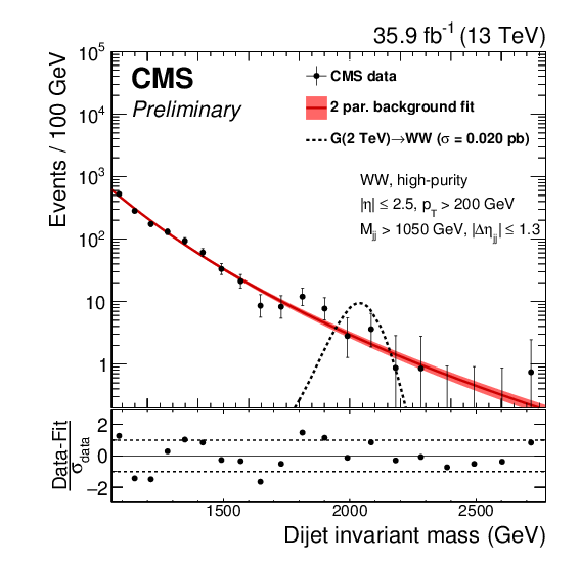
png pdf |
Figure 2-a:
Final ${m_\mathrm {jj}}$ distributions for the dijet analysis in the signal regions using 35.9 fb$^{-1}$ of 13 TeV data. The HP category is shown for the WW category. The solid curve represents a background-only fit to the data distribution where the filled red area corresponds to the 1sigma statistical error of the fit. The data are shown as black markers. |

png pdf |
Figure 2-b:
Final ${m_\mathrm {jj}}$ distributions for the dijet analysis in the signal regions using 35.9 fb$^{-1}$ of 13 TeV data. The LP category is shown for the WW category. The solid curve represents a background-only fit to the data distribution where the filled red area corresponds to the 1sigma statistical error of the fit. The data are shown as black markers. |
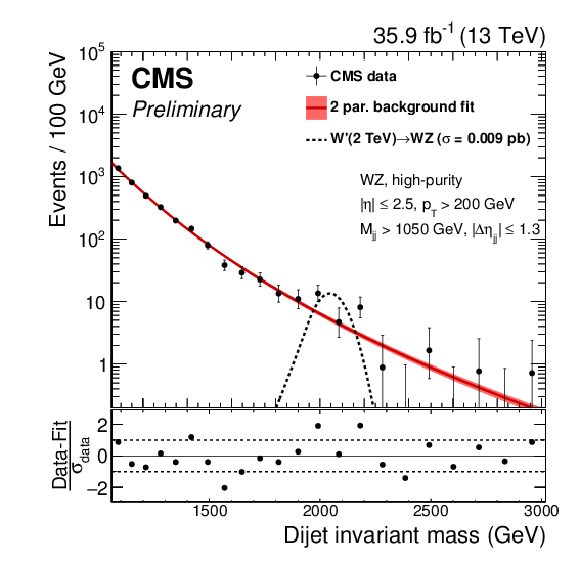
png pdf |
Figure 2-c:
Final ${m_\mathrm {jj}}$ distributions for the dijet analysis in the signal regions using 35.9 fb$^{-1}$ of 13 TeV data. The HP category is shown for the WZ category. The solid curve represents a background-only fit to the data distribution where the filled red area corresponds to the 1sigma statistical error of the fit. The data are shown as black markers. |

png pdf |
Figure 2-d:
Final ${m_\mathrm {jj}}$ distributions for the dijet analysis in the signal regions using 35.9 fb$^{-1}$ of 13 TeV data. The LP category is shown for the WZ category. The solid curve represents a background-only fit to the data distribution where the filled red area corresponds to the 1sigma statistical error of the fit. The data are shown as black markers. |

png pdf |
Figure 2-e:
Final ${m_\mathrm {jj}}$ distributions for the dijet analysis in the signal regions using 35.9 fb$^{-1}$ of 13 TeV data. The HP category is shown for the ZZ category. The solid curve represents a background-only fit to the data distribution where the filled red area corresponds to the 1sigma statistical error of the fit. The data are shown as black markers. |
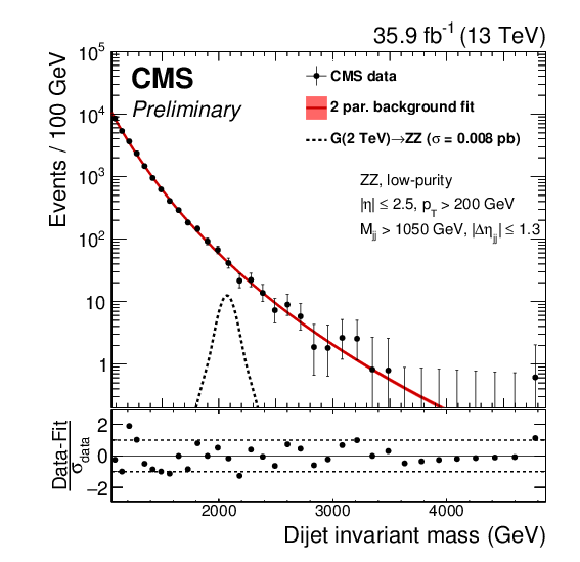
png pdf |
Figure 2-f:
Final ${m_\mathrm {jj}}$ distributions for the dijet analysis in the signal regions using 35.9 fb$^{-1}$ of 13 TeV data. The LP category is shown for the ZZ category. The solid curve represents a background-only fit to the data distribution where the filled red area corresponds to the 1sigma statistical error of the fit. The data are shown as black markers. |
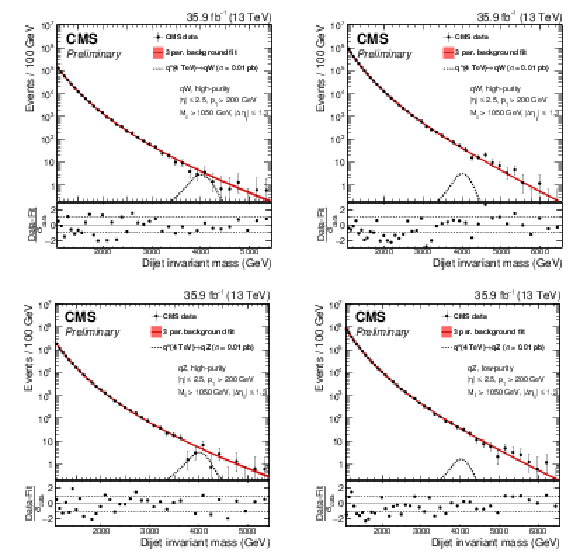
png pdf |
Figure 3:
Final ${m_\mathrm {jj}}$ distributions for the dijet analysis in the signal regions using 35.9 fb$^{-1}$ of 13 TeV data. On the left, the HP, and on the right, the LP categories are shown for the qW and qZ categories from top to bottom. The solid curve represents a background-only fit to the data distribution where the filled red area corresponds to the 1sigma statistical error of the fit. The data are shown as black markers. |

png pdf |
Figure 3-a:
Final ${m_\mathrm {jj}}$ distributions for the dijet analysis in the signal regions using 35.9 fb$^{-1}$ of 13 TeV data. The HP category is shown for the qW category. The solid curve represents a background-only fit to the data distribution where the filled red area corresponds to the 1sigma statistical error of the fit. The data are shown as black markers. |

png pdf |
Figure 3-b:
Final ${m_\mathrm {jj}}$ distributions for the dijet analysis in the signal regions using 35.9 fb$^{-1}$ of 13 TeV data. The LP category is shown for the qW category. The solid curve represents a background-only fit to the data distribution where the filled red area corresponds to the 1sigma statistical error of the fit. The data are shown as black markers. |

png pdf |
Figure 3-c:
Final ${m_\mathrm {jj}}$ distributions for the dijet analysis in the signal regions using 35.9 fb$^{-1}$ of 13 TeV data. The HP category is shown for the qZ category. The solid curve represents a background-only fit to the data distribution where the filled red area corresponds to the 1sigma statistical error of the fit. The data are shown as black markers. |
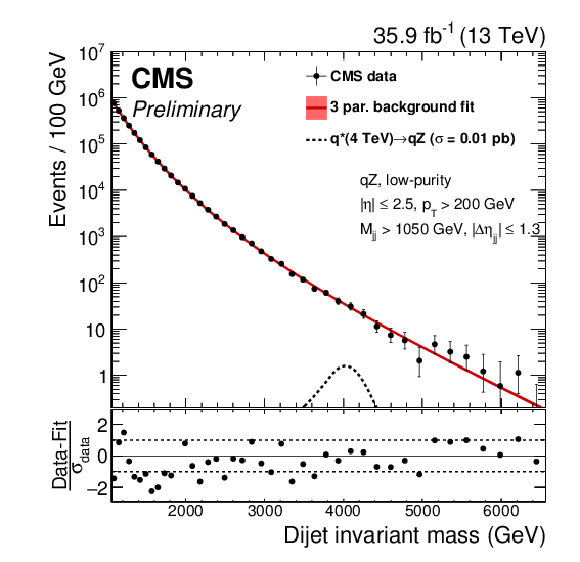
png pdf |
Figure 3-d:
Final ${m_\mathrm {jj}}$ distributions for the dijet analysis in the signal regions using 35.9 fb$^{-1}$ of 13 TeV data. The LP category is shown for the qZ category. The solid curve represents a background-only fit to the data distribution where the filled red area corresponds to the 1sigma statistical error of the fit. The data are shown as black markers. |

png pdf |
Figure 4:
Dijet invariant mass distribution for different signal mass hypotheses of the q* model decaying to qZ (left) and the bulk graviton model decaying to a pair of Z bosons (right) used to extract the signal shape. |

png pdf |
Figure 4-a:
Dijet invariant mass distribution for different signal mass hypotheses of the q* model decaying to qZ. |

png pdf |
Figure 4-b:
The bulk graviton model decaying to a pair of Z bosons used to extract the signal shape. |

png pdf |
Figure 5:
Observed (black solid) and expected (black dashed) 95% CL upper limits on the production of a narrow-width resonance decaying to a pair of vector bosons for different signal hypotheses. Limits are set in the context of a spin-1 neutral Z' (left) and charged W' (right) resonances, and compared with the prediction of the HVT modelB. On the bottom, limits are set in the context of a bulk graviton decaying into WW (left) and ZZ (right) with $ {\tilde{k}}= $ 0.5 and compared with the model prediction. Signal cross section uncertainties are displayed as a red checked band. |

png pdf |
Figure 5-a:
Observed (black solid) and expected (black dashed) 95% CL upper limits on the production of a narrow-width resonance decaying to a pair of vector bosons in the context of a spin-1 neutral Z' resonance, and compared with the prediction of the HVT modelB. Signal cross section uncertainties are displayed as a red checked band. |

png pdf |
Figure 5-b:
Observed (black solid) and expected (black dashed) 95% CL upper limits on the production of a narrow-width resonance decaying to a pair of vector bosons in the context of a spin-1 charged W' resonance, and compared with the prediction of the HVT modelB. Signal cross section uncertainties are displayed as a red checked band. |
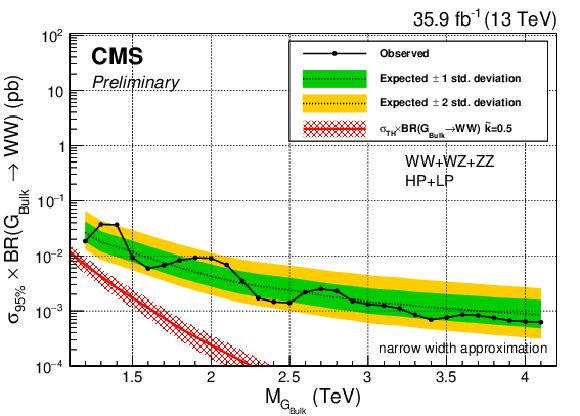
png pdf |
Figure 5-c:
Observed (black solid) and expected (black dashed) 95% CL upper limits on the production of a narrow-width resonance decaying to a pair of vector bosons in the context of a bulk graviton decaying into WW with $ {\tilde{k}}= $ 0.5 and compared with the model prediction. Signal cross section uncertainties are displayed as a red checked band. |

png pdf |
Figure 5-d:
Observed (black solid) and expected (black dashed) 95% CL upper limits on the production of a narrow-width resonance decaying to a pair of vector bosons in the context of a bulk graviton decaying into ZZ with $ {\tilde{k}}= $ 0.5 and compared with the model prediction. Signal cross section uncertainties are displayed as a red checked band. |

png pdf |
Figure 6:
Observed (black solid) and expected (black dashed) 95% CL upper limits on the production of an excited quark resonance decaying into qW (left) or qZ (right). Signal cross section uncertainties are displayed as a red checked band. |

png pdf |
Figure 6-a:
Observed (black solid) and expected (black dashed) 95% CL upper limits on the production of an excited quark resonance decaying into qW. Signal cross section uncertainties are displayed as a red checked band. |

png pdf |
Figure 6-b:
Observed (black solid) and expected (black dashed) 95% CL upper limits on the production of an excited quark resonance decaying into qZ. Signal cross section uncertainties are displayed as a red checked band. |
| Tables | |

png pdf |
Table 1:
Data-to-simulation scale factors for the efficiency of the ${\tau _{21}}$ selection used in this analysis, as extracted from a top-quark enriched data sample and from simulation. |

png pdf |
Table 2:
Summary of the signal systematic uncertainties for the analysis and their impact on the event yield in the signal region and on the reconstructed ${m_{ {\mathrm {V}} {\mathrm {V}} }} $ shape (mean and width). The jet-mass and V-tagging uncertainties result in migrations between event categories. The effects of the PDF and scale uncertainties on the signal cross section are not included as nuisance parameters in the limit setting procedure, but are attached to the theory predictions. |
| Summary |
| We have presented a search for new resonances decaying to WW, ZZ, WZ, qW or qZ in which the bosons decay hadronically. W and Z bosons that decay to quarks are identified by requiring a jet with mass compatible with the W or Z boson mass, respectively. Additional information from jet substructure is used to reduce the background from QCD multijet processes. No evidence for a signal is found, and the result is interpreted as an upper limit on the production cross section as a function of the resonance mass in the context of the bulk graviton, and HVT model "B" W' and Z' models as well as in the context of excited quark resonances $\rm{q^*}$. For the HVT model B, we exclude W' and Z' resonances with masses below 3.6 TeV and 2.7 TeV, respectively. In the narrow-width bulk graviton model, cross sections are excluded in the range 37.1-0.6 fb. Exclusion limits are set at a confidence level of 95% on the production of excited quark resonances $\rm{q^*}$ decaying to qW and qZ for masses less than 5.0 TeV and TeV, respectively. This search sets the most stringent mass limits on a $\rm{q^*}$ resonance in the qW and qZ decay mode, as well as a W' or Z' resonance in the diboson decay mode. |
| Additional Figures | |

png pdf |
Additional Figure 1:
Event display for a VV candidate in the ZZ high-purity category. |

png pdf |
Additional Figure 2:
Event display for a VV candidate in the ZZ high-purity category. |
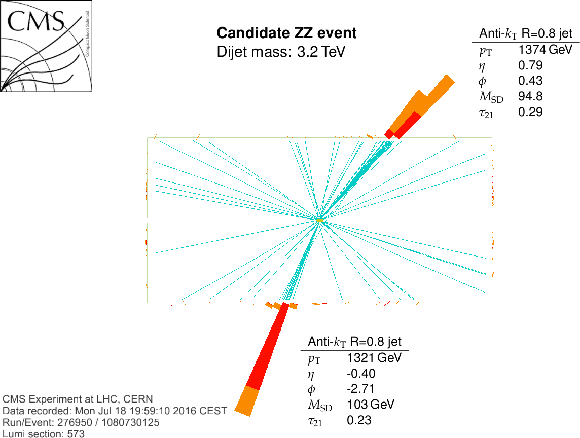
png pdf |
Additional Figure 3:
Event display for a VV candidate in the ZZ high-purity category. |

png pdf |
Additional Figure 4:
Event display for a jet from the high-purity Z category. |

png pdf |
Additional Figure 5:
Event display for a VV candidate in the ZZ high-purity category. |

png pdf |
Additional Figure 6:
Event display for a VV candidate in the WW high-purity category. |

png pdf |
Additional Figure 7:
Event display for a VV candidate in the WW high-purity category. |
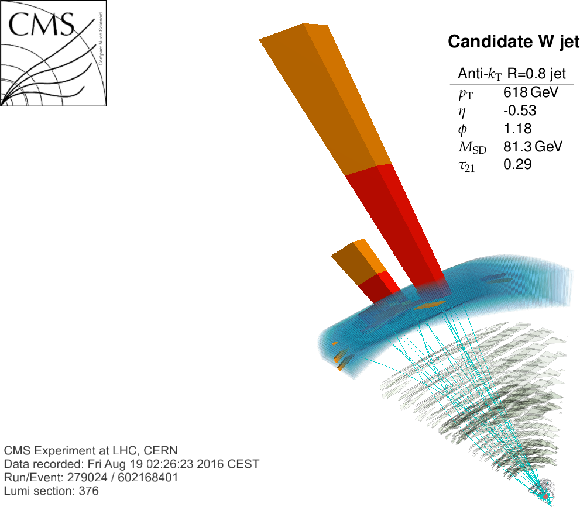
png pdf |
Additional Figure 8:
Event display for a jet from the high-purity W category. |
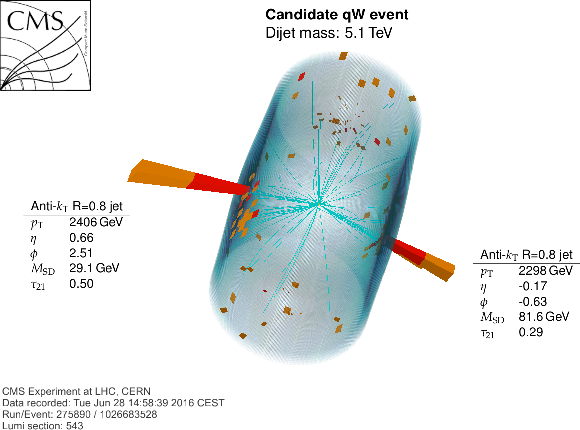
png pdf |
Additional Figure 9:
Event display for a qV candidate in the qW high-purity category. |

png pdf |
Additional Figure 10:
Event display for a qV candidate in the qW high-purity category. |

png pdf |
Additional Figure 11:
Event display for a qV candidate in the qW high-purity category. |
| References | ||||
| 1 | K. Agashe, H. Davoudiasl, G. Perez, and A. Soni | Warped Gravitons at the LHC and Beyond | PRD 76 (2007) | hep-ph/0701186 |
| 2 | A. L. Fitzpatrick, J. Kaplan, L. Randall, and L.-T. Wang | Searching for the Kaluza-Klein Graviton in Bulk RS Models | JHEP 09 (2007) | hep-ph/0701150 |
| 3 | O. Antipin, D. Atwood, and A. Soni | Search for RS gravitons via W(L)W(L) decays | PLB 666 (2008) | 0711.3175 |
| 4 | L. Randall and R. Sundrum | A Large mass hierarchy from a small extra dimension | PRL 83 (1999) | hep-ph/9905221 |
| 5 | L. Randall and R. Sundrum | An Alternative to compactification | PRL 83 (1999) | hep-th/9906064 |
| 6 | D. Pappadopulo, A. Thamm, R. Torre, and A. Wulzer | Heavy Vector Triplets: Bridging Theory and Data | JHEP 09 (2014) | 1402.4431 |
| 7 | C. Grojean, E. Salvioni, and R. Torre | A weakly constrained W' at the early LHC | JHEP 07 (2011) 002 | 1103.2761 |
| 8 | E. Salvioni, G. Villadoro, and F. Zwirner | Minimal Z-prime models: Present bounds and early LHC reach | JHEP 11 (2009) 068 | 0909.1320 |
| 9 | B. Bellazzini, C. Cs\'aki, and J. Serra | Composite Higgses | EPJC 74 (2014) 2766 | 1401.2457 |
| 10 | R. Contino, D. Marzocca, D. Pappadopulo, and R. Rattazzi | On the effect of resonances in composite Higgs phenomenology | JHEP 10 (2011) | 1109.1570 |
| 11 | D. Marzocca, M. Serone, and J. Shu | General composite Higgs models | JHEP 08 (2012) | 1205.0770 |
| 12 | D. Greco and D. Liu | Hunting composite vector resonances at the LHC: naturalness facing data | JHEP 12 (2014) 126 | 1410.2883 |
| 13 | M. Schmaltz and D. Tucker-Smith | Little Higgs review | Ann. Rev. Nucl. Part. Sci. 55 (2005) 229 | hep-ph/0502182 |
| 14 | N. Arkani-Hamed, A. Cohen, E. Katz, and A. Nelson | The Littlest Higgs | JHEP 07 (2002) 034 | hep-ph/0206021 |
| 15 | G. Altarelli, B. Mele, and M. Ruiz-Altaba | Searching for new heavy vector bosons in $ p\bar{p} $ colliders | Zeitschrift fur Physik C Particles and Fields 45 (1989) 109 | |
| 16 | ATLAS Collaboration | Search for new resonances decaying to a $ W $ or $ Z $ boson and a Higgs boson in the $ \ell^+ \ell^- b\bar b $, $ \ell \nu b\bar b $, and $ \nu\bar{\nu} b\bar b $ channels with $ pp $ collisions at $ \sqrt s = 13 $ TeV with the ATLAS detector | PLB 765 (2017) 32 | 1607.05621 |
| 17 | ATLAS Collaboration | Searches for heavy diboson resonances in $ pp $ collisions at $ \sqrt{s}= $ 13 TeV with the ATLAS detector | JHEP 09 (2016) 173 | 1606.04833 |
| 18 | CMS Collaboration | Search for new resonances decaying via WZ to leptons in proton-proton collisions at $ \sqrt s = $ 8 TeV | PLB 740 (2015) | CMS-EXO-12-025 1407.3476 |
| 19 | CMS Collaboration | Search for massive resonances decaying into pairs of boosted bosons in semi-leptonic final states at $ \sqrt{s} = $ 8 TeV | JHEP 08 (2014) | CMS-EXO-13-009 1405.3447 |
| 20 | CMS Collaboration | Search for massive resonances in dijet systems containing jets tagged as W or Z boson decays in pp collisions at $ \sqrt{s} $ = 8 TeV | JHEP 08 (2014) | CMS-EXO-12-024 1405.1994 |
| 21 | CMS Collaboration | Search for massive WH resonances decaying into the $ \ell \nu \mathrm{b} \overline{\mathrm{b}} $ final state at $ \sqrt{s}= $ 8 TeV | EPJC 76 (2016) | CMS-EXO-14-010 1601.06431 |
| 22 | CMS Collaboration | Search for a massive resonance decaying into a Higgs boson and a W or Z boson in hadronic final states in proton-proton collisions at $ \sqrt{s}= $ 8 TeV | JHEP 02 (2016) | CMS-EXO-14-009 1506.01443 |
| 23 | CMS Collaboration | Search for Narrow High-Mass Resonances in Proton-Proton Collisions at $ \sqrt{s} $ = 8 TeV Decaying to a Z and a Higgs Boson | PLB 748 (2015) | CMS-EXO-13-007 1502.04994 |
| 24 | ATLAS Collaboration | Search for high-mass diboson resonances with boson-tagged jets in proton-proton collisions at $ \sqrt{s}= $ 8 TeV with the ATLAS detector | JHEP 12 (2015) | 1506.00962 |
| 25 | ATLAS Collaboration | Search for production of $ WW/WZ $ resonances decaying to a lepton, neutrino and jets in $ pp $ collisions at $ \sqrt{s}= $ 8 TeV with the ATLAS detector | EPJC 75 (2015), no. 5, , [Erratum: Eur. Phys. J.C75,370(2015)] | 1503.04677 |
| 26 | ATLAS Collaboration | Search for WZ resonances in the fully leptonic channel using pp collisions at $ \sqrt{s} $ = 8 TeV with the ATLAS detector | PLB 737 (2014) | 1406.4456 |
| 27 | ATLAS Collaboration | Search for a new resonance decaying to a W or Z boson and a Higgs boson in the $ \ell \ell / \ell \nu / \nu \nu + b \bar{b} $ final states with the ATLAS detector | EPJC 75 (2015) | 1503.08089 |
| 28 | ATLAS Collaboration | A Search for Resonances Decaying to a $ W $ or $ Z $ Boson and a Higgs Boson in the $ q\bar{q}^{(')}b\bar{b} $ Final State | ATLAS-CONF-2016-083 | |
| 29 | ATLAS Collaboration | Searches for heavy ZZ and ZW resonances in the $ \ell\ell qq $ and $ \nu\nu qq $ final states in pp collisions at $ \sqrt{s} $ = 13 TeV with the ATLAS detector | ATLAS-CONF-2016-082 | |
| 30 | ATLAS Collaboration | Search for diboson resonance production in the $ \ell\nu qq $ final state using pp collisions at $ \sqrt{s} $ = 13 TeV with the ATLAS detector at the LHC | ATLAS-CONF-2016-062 | |
| 31 | ATLAS Collaboration | Search for resonances with boson-tagged jets in 15.5 fb$ ^{-1} $ of $ pp $ collisions at $ \sqrt{s}= $ 13 TeV collected with the ATLAS detector | ATLAS-CONF-2016-055 | |
| 32 | CMS Collaboration | Search for massive resonances decaying into WW, WZ or ZZ bosons in proton-proton collisions at $ \sqrt{s} = $ 13 TeV | B2G-16-004 | CMS-B2G-16-004 1612.09159 |
| 33 | F. Dias et al. | Combination of Run-1 Exotic Searches in Diboson Final States at the LHC | JHEP 04 (2016) | 1512.03371 |
| 34 | CMS Collaboration | Search for heavy resonances decaying into a vector boson and a Higgs boson in hadronic final states with 2016 data | B2G-17-002 | CMS-PAS-B2G-17-002 |
| 35 | CMS Collaboration | Search for heavy resonances decaying into a Z boson and a W boson in the $ \ell^+\ell^- $qq final state | B2G-16-022 | CMS-PAS-B2G-16-022 |
| 36 | CMS Collaboration | Search for massive resonances decaying into WW, WZ, ZZ, qW and qZ in the dijet final state at $ \sqrt{s} $ = 13 TeV using 2016 data | B2G-16-021 | CMS-PAS-B2G-16-021 |
| 37 | CMS Collaboration | Search for new resonances decaying to WW/WZ $ \rightarrow \ell\nu $q | ||
| 38 | U. Baur, I. Hinchliffe, and D. Zeppenfeld | Excited Quark Production at Hadron Colliders | Int. J. Mod. Phys. A 2 (1987) | |
| 39 | U. Baur, M. Spira, and P. M. Zerwas | Excited-quark and -lepton production at hadron colliders | PRD 42 (Aug, 1990) | |
| 40 | CMS Collaboration | Search for narrow resonances using the dijet mass spectrum in $ pp $ collisions at $ \sqrt{s}= $ 8 TeV | PRD 87 (Jun, 2013) | |
| 41 | ATLAS Collaboration | ATLAS search for new phenomena in dijet mass and angular distributions using pp collisions at $ \sqrt{s}= $ 7 TeV | Journal of High Energy Physics 2013 (2013), no. 1 | |
| 42 | ATLAS Collaboration | Search for new phenomena in dijet events collected in 2015 and 2016 $ pp $ collisions with the ATLAS detector at $ \sqrt{s}= $ 13 TeV | ATLAS-CONF-2016-069 | |
| 43 | CMS Collaboration | Search for dijet resonances in proton-proton collisions at $ \sqrt{s}= $ 13 TeV and constraints on dark matter and other models | PLB (2016) | CMS-EXO-16-032 1611.03568 |
| 44 | R. M. Harris and K. Kousouris | Searches for Dijet Resonances at Hadron Colliders | Int. J. Mod. Phys. A 26 (2011) | 1110.5302 |
| 45 | ATLAS Collaboration | Search for new phenomena in photon+jet events collected in proton--proton collisions at $ \sqrt{s}= $ 8 TeV with the ATLAS detector | PLB 728 (2014) | 1309.3230 |
| 46 | ATLAS Collaboration | Search for new phenomena with photon+jet events in proton-proton collisions at $ \sqrt{s}= $ 13 TeV with the ATLAS detector | JHEP 03 (2016) 041 | 1512.05910 |
| 47 | CMS Collaboration | Search for excited quarks in the $ \gamma + $jet final state in proton-proton collisions at $ \sqrt{s}= $ 8 TeV TeV | PLB 738 (2014) 274 | CMS-EXO-13-003 1406.5171 |
| 48 | CMS Collaboration | Search for heavy resonances in the W/Z-tagged dijet mass spectrum in pp collisions at 7 TeV | PLB 723 (2013) | CMS-EXO-11-095 1212.1910 |
| 49 | CMS Collaboration | Search for anomalous production of highly boosted $ Z $ bosons decaying to $ \mu^+ \mu^- $ in proton-proton collisions at $ \sqrt{s}= $ 7 TeV | PLB 722 (2013) | CMS-EXO-11-025 1210.0867 |
| 50 | CMS Collaboration | V Tagging Observables and Correlations | CMS-PAS-JME-14-002 | CMS-PAS-JME-14-002 |
| 51 | CMS Collaboration | The CMS experiment at the CERN LHC | JINST 3 (2008) | CMS-00-001 |
| 52 | J. Alwall et al. | The automated computation of tree-level and next-to-leading order differential cross sections, and their matching to parton shower simulations | JHEP 07 (2014) | 1405.0301 |
| 53 | T. Sjostrand, S. Mrenna, and P. Z. Skands | PYTHIA 6.4 Physics and Manual | JHEP 05 (2006) | hep-ph/0603175 |
| 54 | T. Sjostrand, S. Mrenna, and P. Z. Skands | A Brief Introduction to PYTHIA 8.1 | CPC 178 (2008) | 0710.3820 |
| 55 | R. D. Ball et al. | Impact of Heavy Quark Masses on Parton Distributions and LHC Phenomenology | Nucl. Phys. B 849 (2011) | 1101.1300 |
| 56 | GEANT4 Collaboration | GEANT4: A Simulation toolkit | NIMA 506 (2003) | |
| 57 | CMS Collaboration | Particle-Flow Event Reconstruction in CMS and Performance for Jets, Taus, and MET | CDS | |
| 58 | CMS Collaboration | Commissioning of the Particle-flow Event Reconstruction with the first LHC collisions recorded in the CMS detector | CDS | |
| 59 | M. Cacciari, G. P. Salam, and G. Soyez | FastJet User Manual | EPJC 72 (2012) | 1111.6097 |
| 60 | M. Cacciari, G. P. Salam, and G. Soyez | The Anti-k(t) jet clustering algorithm | JHEP 04 (2008) | 0802.1189 |
| 61 | CMS Collaboration | Determination of Jet Energy Calibration and Transverse Momentum Resolution in CMS | JINST 6 (2011) | CMS-JME-10-011 1107.4277 |
| 62 | D. Bertolini, P. Harris, M. Low, and N. Tran | Pileup per particle identification | Journal of High Energy Physics 2014 (2014), no. 10 | |
| 63 | CMS Collaboration | Pileup Removal Algorithms | ||
| 64 | CMS Collaboration | Identification techniques for highly boosted W bosons that decay into hadrons | JHEP 12 (2014) | CMS-JME-13-006 1410.4227 |
| 65 | CMS Collaboration | Studies of jet mass in dijet and W/Z + jet events | JHEP 05 (2013) | CMS-SMP-12-019 1303.4811 |
| 66 | M. Dasgupta, A. Fregoso, S. Marzani, and G. P. Salam | Towards an understanding of jet substructure | JHEP 09 (2013) 029 | 1307.0007 |
| 67 | M. Dasgupta, A. Fregoso, S. Marzani, and A. Powling | Jet substructure with analytical methods | Eur. Phys. J.C 73 (2013), no. 11 | 1307.0013 |
| 68 | A. J. Larkoski, S. Marzani, G. Soyez, and J. Thaler | Soft Drop | JHEP 05 (2014) | 1402.2657 |
| 69 | S. D. Ellis, C. K. Vermilion, and J. R. Walsh | Techniques for improved heavy particle searches with jet substructure | PRD 80 (2009) | 0903.5081 |
| 70 | S. D. Ellis, C. K. Vermilion, and J. R. Walsh | Recombination Algorithms and Jet Substructure: Pruning as a Tool for Heavy Particle Searches | PRD 81 (2010) | 0912.0033 |
| 71 | D. Krohn, J. Thaler, and L.-T. Wang | Jet Trimming | JHEP 02 (2010) | 0912.1342 |
| 72 | S. Catani, Y. L. Dokshitzer, M. H. Seymour, and B. R. Webber | Longitudinally invariant $ K_t $ clustering algorithms for hadron hadron collisions | Nucl. Phys. B 406 (1993) | |
| 73 | S. D. Ellis and D. E. Soper | Successive combination jet algorithm for hadron collisions | PRD 48 (1993) | hep-ph/9305266 |
| 74 | M. Wobisch and T. Wengler | Hadronization corrections to jet cross-sections in deep inelastic scattering | in Monte Carlo generators for HERA physics. Proceedings, Workshop, Hamburg, Germany, 1998-1999 1998 | hep-ph/9907280 |
| 75 | J. Thaler and K. Van Tilburg | Identifying Boosted Objects with N-subjettiness | JHEP 03 (2011) | 1011.2268 |
| 76 | CMS Collaboration | CMS luminosity measurements for the 2016 data taking period | ||
| 77 | CMS Collaboration | Tracking and Primary Vertex Results in First 7 TeV Collisions | CDS | |
| 78 | M. Bahr et al. | Herwig++ Physics and Manual | EPJC 58 (2008) | 0803.0883 |
| 79 | CMS Collaboration | Search for narrow resonances in dilepton mass spectra in proton-proton collisions at $ \sqrt{s} $ = 13 TeV and combination with 8 TeV data | PLB (2016) | CMS-EXO-15-005 1609.05391 |
| 80 | M. J. Oreglia | PhD thesis, Stanford University, 1980 SLAC Report SLAC-R-236 | ||
| 81 | CMS Collaboration | CMS Luminosity Measurement for the 2015 Data Taking Period | CMS-PAS-LUM-15-001 | CMS-PAS-LUM-15-001 |
| 82 | M. Cacciari et al. | The $ \mathrm{ t \bar{t} } $ cross-section at 1.8-TeV and 1.96-TeV: A Study of the systematics due to parton densities and scale dependence | JHEP 04 (2004) 068 | hep-ph/0303085 |
| 83 | S. Catani, D. de Florian, M. Grazzini, and P. Nason | Soft gluon resummation for Higgs boson production at hadron colliders | JHEP 07 (2003) 028 | hep-ph/0306211 |
| 84 | A. L. Read | Presentation of search results: The CL(s) technique | JPG 28 (2002) | |
| 85 | T. Junk | Confidence level computation for combining searches with small statistics | NIMA 434 (1999) | hep-ex/9902006 |

|
Compact Muon Solenoid LHC, CERN |

|

|

|

|

|

|